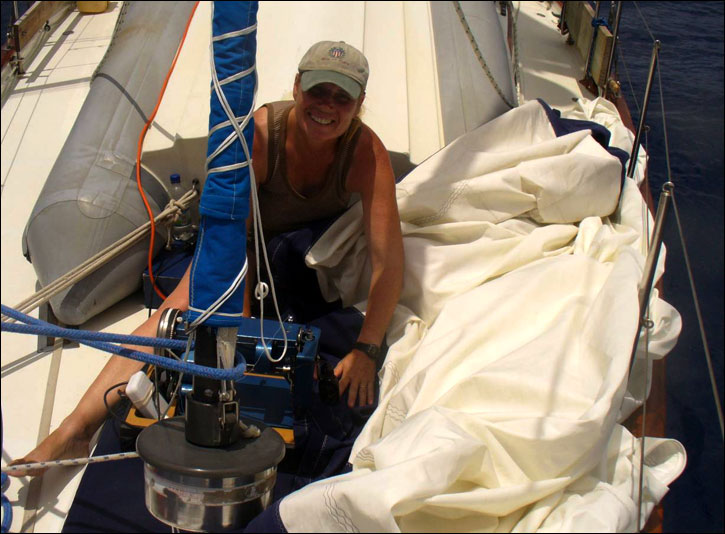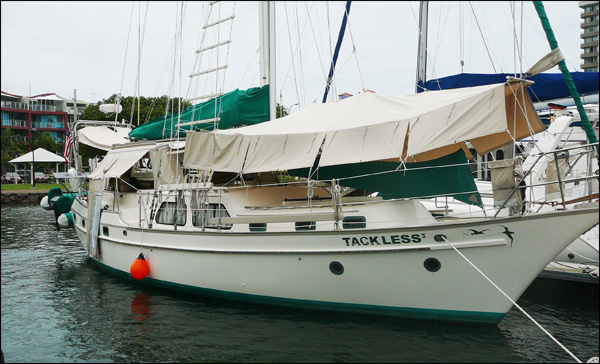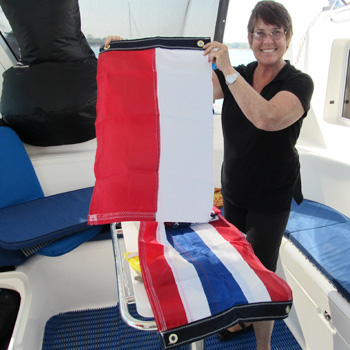 |
| Photo: Marcie Connelly-Lynn, NINE OF CUPS |
Cruising boats come in all shapes, sizes and materials, but what distinguishes one from another in the crowded anchorage is the way we dress them. Thus, you might think all the pretty canvas a boat sports is for appearances only, but reality is that UV protection for sails, equipment and crew is the driving force. The farther a boat travels into the tropics, the more UV protection is essential, and, of course, the longer a boat travels, the more need there’s going to be for repairs, often in remote situations. Because every cruising boat afloat is unique, as are its needs, every solution will be unique. So … it’s pretty handy to be able to sew.
 |
| TACKLESS II displaying a bunch of canvas projects (foredeck awning, gib sheet bags, side awnings, cradle cover, staysail cover) |
Several different kinds of sewing are called for on a cruising boat. There’s big, complicated stuff – sails, sail covers and stackpacks, awnings, biminis, and cockpit cushions – that require real skills, workspace and an industrial sewing machine to handle the multiple layers of heavy fabric that must be stitched through. There are smaller, more domestic type projects – courtesy flags, utility bags and organizers, pillows and cushions, fitted sheets, and covers etc. – than can be managed with a home-style machine. There are emergency repairs to sails, dodgers, and covers that can be made in place with the ingenious sewing awl. And finally there is marlinspike sewing – making splices and whipping lines – that calls for its own set of tools.
 |
 |
| Photo: Margie Benziger, PEREGRINA |
Sewing is a skill that often (but not always) comes aboard with the female cruising partner. If your mother succeeded in teaching you this skill, you have a head start in setting up to sew on your boat. A brand new cruising boat is (pardon the pun) a blank canvas for someone who loves to sew.
However, many of us in recent generations dodged this old-fashioned skill-training, so now what? Is it essential?
I canvassed (oh, dear!) the Admirals and got answers that ranged the spectrum. Some like Betty Lee (Quantum Leap), Linda (Hawkeye), and Mary (Camryka) sewed as girls and brought that pleasure and ability to their boats, setting themselves up with industrial grade sewing machines to handle most of the sailing projects and repairs they might need, and even making money along the way by sewing for other cruisers.
Others like Sheri of Procyon, Judy of Ursa Minor, and, yes….myself… made it thousands of sea miles relying almost exclusively on shore-side canvas workers. Other Admirals like Daria of Aleria, Wendy of Velella, Lisa of Lady Galadriel, and Jane of Lionheart fell in between; they know how to sew and equipped themselves to tackle the more manageable domestic-scale projects — like courtesy flags, organizer bags and awning repairs — but leave the big jobs to professionals who have the machines, space, and know-how to handle them.
So, the answer is, NO, you don’t absolutely have to know how to sew to go cruising. But don’t stop reading! While sewing as a skill and the space to do it are found in most places you will visit, quite often the materials needed to do it right are not. Below, we’ll list materials you’d be wise to bring with you.
Also, you may decide this is a horizon you want to broaden. There are marine sewing courses offered around the country, one of the most famous of which is Carol Hasse’s course at Port Townsend Sails. Sailrite, Inc, an online source for everything related to marine sewing, also has instruction books, videos and kits. Plus, sewing can be an ideal skill to learn from a cruising mentor. Cruiser nodes like Trinidad (which happens to be a fabric nirvana) often support cruiser sewing groups.
The easiest first stop for setting up your boat for sewing is Sailrite (www.sailrite.com), a second-generation family business, whose objective from the start was to provide a source of instruction and materials for amateur sailmakers and canvas-workers. Its founder, Jim Grant, wrote The Complete Canvasworker’s Guide, which even I had on my boat.
Sailrite is the best known vendor of heavy-duty sewing machines for sail and canvas work, which feature straight and zigzag stitching and a walking foot that moves the layers of heavy fabric together through the machine. They are beautiful and pricey. Several Admirals have Sailrite machines. Several others, however have old-fashioned hand-me-down sewing machines from the 40s and 50s – like a Pfaff 230, while Mary had a Reed’s Sailmaker machine her husband bought in the 80s. Older machines (I’ve even seen hand-crank Singers), found second or third-hand, often have strong-enough motors to do much of what most cruisers need.
Today’s “canvas” is most often Sunbrella™, colorful solution-dyed acrylic fabric which is water-resistant and stands up well in the cruising environment. Since aesthetics are at least part of our motivation, think carefully about your color scheme from the outset. You’ll be living with it a long time. Dark colors are eye-catching, but hotter and provide a darker shade.
 |
| Hammock bag, under kayak |
On Tackless II we chose a two-toned theme: Erin Green for our sailcovers, but the lighter, cooler Linen for our bimini and shade awnings.
Sunbrella™ fabric is widely found throughout the cruising world, but not always your color(s). If you’re picky about color, you may want to bring with you fabric for future projects, even if not doing the sewing yourself.
Likewise, what isn’t widely found is UV-resistant thread. More expensive, of course, but it pays for itself in durability. Sheri and I, the non-sewers, both learned to bring spools in colors to match our Sunbrella™ to provide to sewers, and the same for UV-resistant zippers and pull tabs particularly for crucial replacements like the dodger roll-up windows and the stack-pack.
Other recommended stuff for all cruisers to carry are snaps, buckles and toggles, particularly to match what you already have. Some of these require a specialized tool to apply them; others just need a mallet! Velcro in spools and nylon webbing (great for reinforcing corners) are useful, as is 2-sided tape, particularly for sail work. “Never use pins in sail work,” says Rita Diehl, a new Admiral who’s worked in sail lofts but says she did not sew aboard!
For serious sewers, Rita recommends keeping a yardstick and T-square for straight cuts to selvage, and dedicating a pair of very sharp scissors for cutting and a soldering iron for sealing synthetic edges. Don’t forget the 3-in-One Oil to lubricate your machine.
Re sail repair, Rita goes on to advise caution. “Hand repairs are best in an emergency. You can really screw up a sail that is not laid out properly, both patching and large seam stitching, because you could create stresses the sail was not designed for, that are harder to correct for later on.”
All cruisers should have a ditty bag with the tools to make emergency repairs and to whip lines. This should include a leather palm, a fid, heavy-duty needles, beeswax, waxed thread, sail tape and patch material. Also a sewing awl. “I am always checking sails and canvas for things that need a stitch here or there with my sewing awl,” says Bette Lee. “It’s best to see to it right away to avoid bigger jobs later on. You know…`a stitch in time’…!” There are videos on using the ingenious sewing awl on YouTube, and most any seamanship book will show the basics of whipping.
 |
| Courtesy flags (Bette Lee Walker of QUANTUM LEAP) |
One of the most popular sewing projects among cruisers is courtesy flags, much cheaper than buying them. Sailrite has a book of patterns for flags of the Caribbean. To go further, carry an atlas of world flags and keep a grab bag full of colorful scraps!
The Admirals together listed over three dozen sewing projects they’ve completed, not counting clothes, costumes, placemats and napkins, or hobbies like quilting! Invariably, they started with simple obvious covers for UV protection, screens for square hatches, or bags for organizing stuff, but ideas proliferated quickly from seeing what other cruisers did. Even those of us who don’t sew ourselves get into the creative game. Tackless II was covered in Sunbrella™ by the time we reached Australia.
Special thanks to the serious sewers: Betty Lee Walker of Quantum Leap and new Admirals Linda Keigher and Rita Diehl.
This article was first published in the Cruising Outpost magazine.
Friend the Admiral at www.facebook.com/admiralsangle
Also on this website
- 5 Tips every Seamless Sailor should know about canvas on her boat! by Annette Baker
